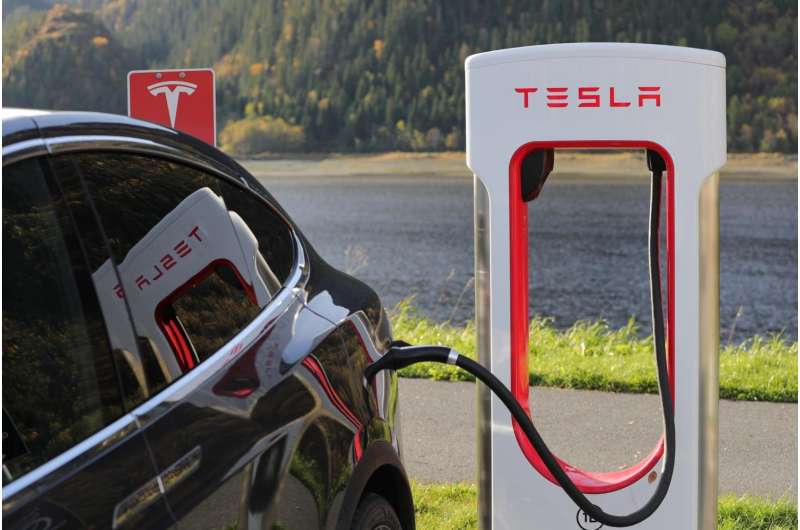Credit: CC0 Public Domain
A team of the CMT-Thermal Engines Institute of the UPV University suggests a new configuration that unites all the benefits of hybrid motors with dual-fuel combustion technology.
Researchers of Valencia's Polytechnic University (UPV) are working to achieve more efficient and less contaminating engines. In this case, their work is focused on hybrid motors. A team of the CMT-Thermal Engines Institute is studying a new configuration that unites all the benefits of hybrid motors and dual-fuel combustion technology.
The first results obtained in the testing grounds of the institute—which have been published in the journal Applied Thermal Engineering—confirm their suitability to tackle the future limits of contaminating and CO2 emissions of the transport sector. These results have also peaked the interest of companies that manufacture vehicles destined for road-based transport such as the Volvo Group Trucks Technology (France) and oil companies such as Aramco Overseas Company (France), which whom the CMT-Thermal Engines Institute of the UPV has initiated a joint project with similar goals to this work.
"The objective of the work was to assess the potential of combining two contaminant-reducing strategies, dual-fuel technology and hybrid engines, to achieve a drastic reduction of CO2 emissions as well as other contaminants that are characteristic from diesel vehicles, such as nitrous oxides and soot," says Jesús Benajes, researcher for the CMT-Thermal Engines.
Simultaneous reduction of the emissions of NOx, soot and CO2
The main novelty of the proposal developed by the UPV researchers resides in the thermal part of the hybrid engine, which has a duel-fuel component. "There are currently engines with a dual-fuel configuration, with natural gas and diesel; there are hybrid engines as everyone knows, but there are none that unite both technologies," says Antonio García, fellow CMT-Thermal Engines researcher.
Among the main conclusions of the study, García highlights that the simulations they have conducted at the testing grounds of the institute show that the dual-fuel combustion technology makes it possible to decrease the emissions of NOx by around 30% compared to Diesel, with very low levels of soot and without hampering the engine's efficiency.
Furthermore, the use of dual-fuel technology in non-pluggable hybrid vehicles makes it possible to decrease the use of petrol by 25% compared to conventional diesel vehicles, as it is possible to optimise the area of use of the dual-fuel combustion engine.
"By increasing the degree of electrification of the power plant—engine—towards pluggable hybrid vehicles, the benefits of combining both technologies are even greater, decreasing the levels of NOx by 70% compared to diesel operations and the emissions of CO2 from the exhaust pipe down to 50 k/km, significantly lower than the 95 g/km enforced by the anti-contamination legislation for the year 2021," says García.
New methodology to optimize the engine
Javier Monsalve, Assistant Professor and researcher of the CMT-Thermal Engines, says that combining the combustion engine and the electric engine adds new "levels of freedom" that must be studied in depth in order to optimize the functioning of the vehicle. In this sense, one of the main results of this work has been obtaining a robust methodology that makes it possible to, by way of computer simulations, choose the optimum design of the hybrid vehicle to combine it with the dual-fuel combustion system, taking into account the conditions of operation.
"This methodology makes it possible to accelerate the development of this type of vehicles, contributing to the implementation of Smart, green and integrated transport, as the Horizon 2020 strategy describes it, as well as the National Plan for Scientific and Technical Research and Innovation, where hybrid vehicles are considered a European strategy and an alternative with strong potential to decarbonize the transport sector through its progressive electrification," says Monsalve.
Assessment of the technology's impact based on an analysis of its lifecycle
The UPV's CMT-Thermal Engines team explains that in order to compare the real benefits of the different transport solutions, the impact of each technology must be analyzed from a global viewpoint. In this sense, the analysis of its lifecycle is one of the most used tools by researchers and bodies in charge of producing anti-contamination policies, and which will presumably be implemented in future legislation.
"Our method differentiates between the foreground system (production, use phase and vehicle end of life processing) from the background system (materials, resources, electricity, provision of infrastructure and generation of waste), which makes it possible to identify the main contaminating components and any possible areas of improvement," concludes Santiago Martínez, researcher at the CMT-Thermal Engines.
More information: Jesús Benajes et al. Emissions reduction from passenger cars with RCCI plug-in hybrid electric vehicle technology, Applied Thermal Engineering (2019). DOI: 10.1016/j.applthermaleng.2019.114430
Provided by Asociacion RUVID
























